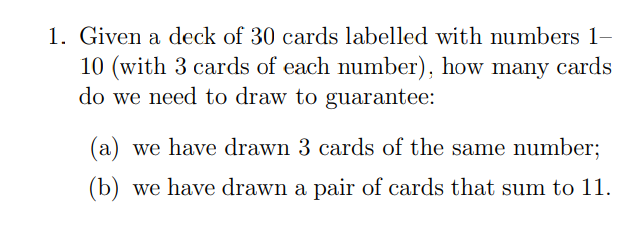1. Given a deck of 30 cards labelled with numbers 1- 10 (with 3 cards of each number), how many cards do we need to draw to guarantee: (a) we have drawn 3 cards of the same number3; (b) we have drawn a pair of cards that sum to 11.
1. Given a deck of 30 cards labelled with numbers 1- 10 (with 3 cards of each number), how many cards do we need to draw to guarantee: (a) we have drawn 3 cards of the same number3; (b) we have drawn a pair of cards that sum to 11.
A First Course in Probability (10th Edition)
10th Edition
ISBN:9780134753119
Author:Sheldon Ross
Publisher:Sheldon Ross
Chapter1: Combinatorial Analysis
Section: Chapter Questions
Problem 1.1P: a. How many different 7-place license plates are possible if the first 2 places are for letters and...
Related questions
Question
Give full reasoning to the way that is done and explain the formula you used and why that particular formula,or way that you did(doesn't have to be a formula) ?

Transcribed Image Text:1. Given a deck of 30 cards labelled with numbers 1-
10 (with 3 cards of each number), how many cards
do we need to draw to guarantee:
(a) we have drawn 3 cards of the same number;
(b) we have drawn a pair of cards that sum to 11.
Expert Solution
This question has been solved!
Explore an expertly crafted, step-by-step solution for a thorough understanding of key concepts.
Step by step
Solved in 3 steps

Recommended textbooks for you

A First Course in Probability (10th Edition)
Probability
ISBN:
9780134753119
Author:
Sheldon Ross
Publisher:
PEARSON


A First Course in Probability (10th Edition)
Probability
ISBN:
9780134753119
Author:
Sheldon Ross
Publisher:
PEARSON
